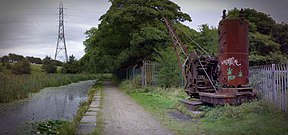Manchester, Bolton & Bury Canal
| Manchester Bolton & Bury Canal | |
|---|---|

The Grade II Listed steam crane at Mount Sion, on the Bury arm
|
|
| Specifications | |
| Maximum boat length | 68 ft 0 in (20.73 m) |
| Maximum boat beam | 14 ft 2 in (4.32 m) (originally 7 ft 0 in or 2.13 m) (Widened from 1794) |
| Locks | 16 (originally 12 and later 17) (5 added for Irwell extension making 17 total, as of 2008 a single deep lock has replaced locks 1&2) |
| Maximum height above sea level | 247 ft (75 m) |
| Status | Under restoration |
| Navigation authority | Canal and River Trust |
| History | |
| Original owner | Manchester Bolton & Bury Canal Company |
| Principal engineer | Matthew Fletcher |
| Other engineer(s) | Hugh Henshall, Charles Roberts, John Nightingale |
| Date of act | 1791 |
| Date of first use | 1797 |
| Date completed | 1808 |
| Date closed | 1924, 1941, 1961 |
| Geography | |
| Start point |
River Irwell, Salford (originally Oldfield Road, Salford) |
| End point | Bury and Bolton |
| Branch(es) | Fletcher's Canal |
The Manchester Bolton & Bury Canal is a disused canal in Greater Manchester, England, built to link Bolton and Bury with Manchester. The canal, when fully opened, was 15 miles 1 furlong (24.3 km) long. It was accessed via a junction with the River Irwell in Salford. Seventeen locks were required to climb to the summit as it passed through Pendleton, heading northwest to Prestolee before it split northwest to Bolton and northeast to Bury. Between Bolton and Bury the canal was level and required no locks. Six aqueducts were built to allow the canal to cross the rivers Irwell and Tonge and several minor roads.
The canal was commissioned in 1791 by local landowners and businessmen and built between 1791 and 1808, during the Golden Age of canal building, at a cost of £127,700 (£8.93 million today). Originally designed for narrow gauge boats, during its construction the canal was altered into a broad gauge canal to allow an ultimately unrealised connection with the Leeds and Liverpool Canal. The canal company later converted into a railway company and built a railway line close to the canal's path, which required modifications to the Salford arm of the canal.
Most of the freight carried was coal from local collieries but, as the mines reached the end of their working lives sections of the canal fell into disuse and disrepair and it was officially abandoned in 1961. In 1987 a society was formed with the aim of restoring the canal for leisure use and, in 2006, restoration began in the area around the junction with the River Irwell in Salford. The canal is currently navigable as far as Oldfield Road, Salford.
...
Wikipedia
